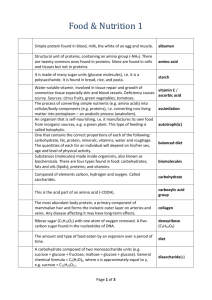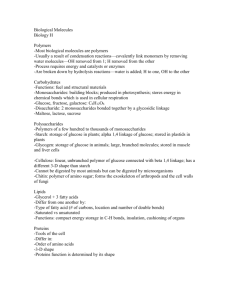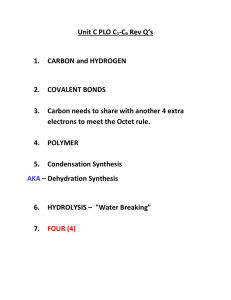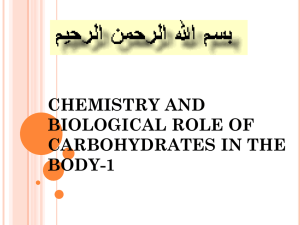Chemistry 20 Chapters 12 Carbohydrates
advertisement
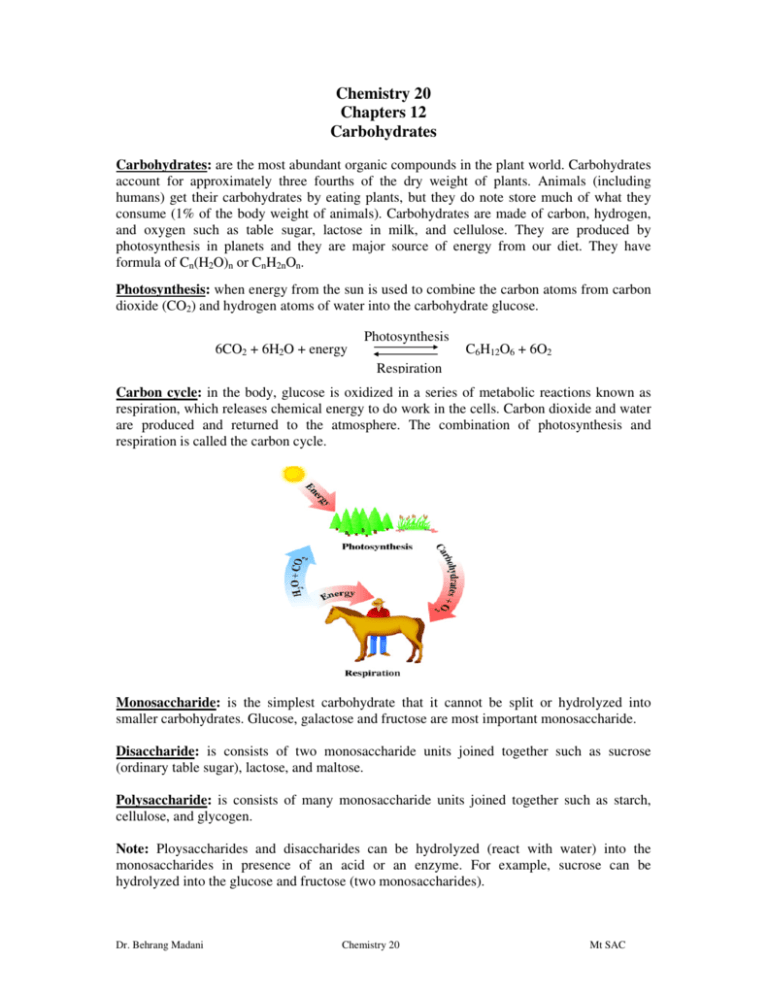
Chemistry 20 Chapters 12 Carbohydrates Carbohydrates: are the most abundant organic compounds in the plant world. Carbohydrates account for approximately three fourths of the dry weight of plants. Animals (including humans) get their carbohydrates by eating plants, but they do note store much of what they consume (1% of the body weight of animals). Carbohydrates are made of carbon, hydrogen, and oxygen such as table sugar, lactose in milk, and cellulose. They are produced by photosynthesis in planets and they are major source of energy from our diet. They have formula of Cn(H2O)n or CnH2nOn. Photosynthesis: when energy from the sun is used to combine the carbon atoms from carbon dioxide (CO2) and hydrogen atoms of water into the carbohydrate glucose. 6CO2 + 6H2O + energy Photosynthesis C6H12O6 + 6O2 Respiration Carbon cycle: in the body, glucose is oxidized in a series of metabolic reactions known as respiration, which releases chemical energy to do work in the cells. Carbon dioxide and water are produced and returned to the atmosphere. The combination of photosynthesis and respiration is called the carbon cycle. Monosaccharide: is the simplest carbohydrate that it cannot be split or hydrolyzed into smaller carbohydrates. Glucose, galactose and fructose are most important monosaccharide. Disaccharide: is consists of two monosaccharide units joined together such as sucrose (ordinary table sugar), lactose, and maltose. Polysaccharide: is consists of many monosaccharide units joined together such as starch, cellulose, and glycogen. Note: Ploysaccharides and disaccharides can be hydrolyzed (react with water) into the monosaccharides in presence of an acid or an enzyme. For example, sucrose can be hydrolyzed into the glucose and fructose (two monosaccharides). Dr. Behrang Madani Chemistry 20 Mt SAC C12H22O11 + H2O Acid or enzyme C6H12O6 + C6H12O6 Structure of monosacchrides: monosaccharides are simple sugars that have an unbranched chain of three to eight carbon atoms, one is a carbonyl group and the rest attached to hydroxyl groups. There are two types of monosaccharide structures: Aldose and Ketose. Aldose: in the aldose, the carbonyl group is on the first carbon (-CHO). Ketose: contains the carbonyl group on the second carbon atom as a ketone (C=O). Note: A monosaccharide with three carbon atoms is a triose, one with four carbon atoms is a tetrose, a pentose has five carbons, and a hexose contains six carbons. A five-carbon monosaccharide that is an aldehyde is called aldopentose. A six-carbon monosaccharide that is a ketone is called ketohexose. Some important monosaccharides: Glucose: is the most common hexose and it is known as blood sugar. Glucose is found in fruits, vegetables, corn syrup, and honey. It is a building block of the disaccharides sucrose, lactose, and maltose and polysaccharides such as starch, cellulose, and glycogen. Galactose: is an aldehexose that dose not occur in the free from in nature. It is obtained as a hydrolysis product of the disaccharide lactose, a sugar found in milk and milk products. Galactose is important in the cellular membranes of the brain and nervous system. The only difference in the structure of glucose and galactose is the arrangement of the –OH group on carbon 4. Galactosemia: is a disease when an enzyme needed to convert galactose to glucose is missing. The accumulation of galactose in the blood and tissues can lead to cataracts, mental retardation, and cirrhosis. The treatment for galactosemia is the removal of all galactosecontaining foods, mainly milk and milk products from the diet. Fructose: is a ketohexose and it is the sweetest of the carbohydrates, twice as sucrose (table sugar). After fructose enters the bloodstream, it is converted to its isomer, glucose. Fructose is found in fruit juices and honey; it is also called fruit sugar. Fructose is also obtained as one of the hydrolysis products of sucrose. Dr. Behrang Madani Chemistry 20 Mt SAC H HO H H CHO OH H OH OH CH 2 OH H HO HO H D-Glucose CHO OH H H OH CH 2 OH D-Galactose CH 2 OH C= O HO H H OH H OH CH 2 OH D-Fructose Fischer projection: in a Fischer projection, the bonds to a chiral atom are drawn as intersecting lines, with the chiral carbon (carbon with four different groups bonded to it) being at the center where the lines cross. The horizontal lines represent the bonds that come forward in the three-dimensional structure, and the vertical lines represent the bonds that point away. Only the stereocenter is in the plane. For carbohydrates two isomers is possible: L and D. We should look at the chiral carbon furthest from the carbonyl group to determine the L and D isomer. The letter L is assigned to the isomer if the –OH group is on the left of the chiral carbon and the letter D is assigned the isomer if the –OH group is on the right of the chiral carbon. Note: The very bottom carbon atom (-CH2OH), is not chiral because it dose not have four different groups bonded to it. H HO H H H CHO OH CHO H OH HO H H OH HO H HO H H OH HO H OH H CH2 OH LD-Glucose CHO OH H OH OH CH2 OH D-Glucose Note: The D isomers are the more common form carbohydrates found in nature than L isomers. Amino sugars: amino sugars contain an –NH2 group in place of an –OH group. Only three amino sugars are common in nature: D-glucosamine, D-mannosamine, and D-galactosamine. CHO H N H2 HO H H OH H OH CH2 OH D-Glucosamine CHO H2N 2 H HO H H OH H OH CH2 OH D-Mannosamine (C-2 stereoisomer CHO H N H2 HO H HO 4 H H OH CH 2 OH D-Galactosamine (C-4 stereoisomer Cyclic structure of monosaccharides: we saw that aldehydes and ketones react with alcohols to form hemiacetals. We also saw that cyclic hemiacetals form very readily when hydroxyl and carbonyl groups are part of the same molecule and that thetir interaction produces a ring. Most of the time, monosaccharides exist as ring structures formed when a carbonyl group and a hydroxyl group in the same molecule react. This form is more stable Dr. Behrang Madani Chemistry 20 Mt SAC than open chain form and is called Haworth structure. The new carbon streocenter created in forming the cyclic structure is called an anomeric carbon. Stereoisomers that differ in configuration only at the anomeric carbon are called anomers. Note: In the cyclic structure, carbon 1 is bonded to a new –OH group. There are two ways to place the –OH group, either up or down, which gives two isomers. The –OH group on carbon 1 is down in the α (alpha) form and up in the β (beta) form (anomers). Note: We can digest starch products (a polysaccharide) such as pasta to obtain glucose because the polysaccharide contains the α isomer of glucose and humans have α-amylase, an enzyme needed for the digestion of starch. We cannot digest paper and wood because cellulose consists of only β-glucose unit and humans do not have β -amylase for the digestion of cellulose. Mutarotation: is the change in specific rotation that accompanies the equilibration of α and β anomers in aqueous solution. β-D-glucose Open-chain form α-D-glucose Chair conformation: sometimes, the six-membered ring is represented as a chair conformation. -OH group on the anomeric carbon is axial for α anomer and equatorial for β anomer. Dr. Behrang Madani Chemistry 20 Mt SAC 6 CH 2 OH O OH(β H β) H 4 OH 1 H HO H 3 2 H OH 6 5 CH2 OH 4 HO HO O 5 3 2 OH 1 OH( β) β-D-Glucose (Chair conformation) β β-D-Glucose (Haworth projection) β Physical properties of Monosaccharides: monosaccharides are colorless, crystalline solids. Because hydrogen bonding is possible between their polar –OH groups and water, all monosaccharides are very soluble in water. They are only slightly soluble in ethanol and are insoluble in nonpolar solvents such as diethyl ether, dichloromethane, and benzene. Chemical reaction of monosaccharides: 1. Formation of Glycosides (acetals): Treatment of the hemiacetal with molecule of alcohol yields an acetal. Treatment of a monosaccharide –all forms of which exist almost exclusively as cyclic hemiacetals- with an alcohol also yields an acetal. A cyclic acetal derived from a monosaccharide is called a glycoside. Mutarotation is not possible in a glycoside because an acetal -unlike a hemiacetal- is no longer in equilibrium with the open-chain carbonylcontaining compound. Glycosides are stable in water and aqueous base; like other acetals, however, they are hydrolyzed in aqueous acid to an alcohol and a monosaccharide. anomeric CH2 OH carbon O OH H + H H + CH3 OH OH H -H2 O HO H glycos idic H OH CH2 OH bond β-D -Glu copyran os e β-D-Glucose O OCH3 H ( β -D -Glu cose) H + OH H H HO CH2 OH OH H H OH H HO OCH3 H OH H OH Methyl -D -glu copyran os ide Methyl -D -glu copyran os ide Methylαα-D-Glucoside Methylββ-D-Glucoside (Methyl β -D -glu coside) (Methyl α-D -glucos ide) 2. Oxidation of monosaccharides: in an aldose, the aldehyde group can be oxidized to a carboxylic acid to form an aldonic acid. When the monosaccharide oxidizes, at the same time, the Cu2+ in Benedict’s reagent is reduced to Cu+, forming a brick-red precipitate of Cu2O. Monosaccharides that reduce another substance such as Benedict’s reagent are called reducing sugars. Ketoses cannot be oxidized directly because we have the ketone group. In the open-chain form, a rearrangement between the hydroxyl group on carbon 1 and the ketone group provides an aldehyde group that can be oxidized. Dr. Behrang Madani Chemistry 20 Mt SAC Note: Enzyme-catalyzed oxidation of the primary alcohol at carbon 6 of hexose yields an uronic acid. H HO H H CHO enzymeOH catalyzed Enzyme H oxidation OH OH CH2 OH D-glucose H HO H H CHO OH H OH OH COOH D-glucuronic acid (a uronic acid) D-Glucuronic acid is serves as an important component of the acidic polysaccharide of connective tissues. The body also uses D-glucuronic acid to detoxify foreign phenols and alcohols. 3. Reduction of monosaccharides: the carbonyl group in both an aldose and ketose can be reduced to give a hydroxyl group. This reduction produces sugar alcohols, which are also called alditols. D-glucose is reduced to D-glucitol (better known as D-sorbitol). Sorbitol is found in the plant world in many berries and cherries, plums, pears, apples, seaweed, and algae. It is about 60% as sweet as sucrose (table sugar). Sugar alcohols are used as sweeteners in many sugar-free products such as diet drinks and sugarless gum (these sugar alcohols can produce some problem such as diarrhea and cataract). Dr. Behrang Madani Chemistry 20 Mt SAC Disaccharides: the most common disaccharides are maltose, lactose, and sucrose. Their hydrolysis, by an acid or an enzyme, gives the following monosaccharides: + Maltose + H2O H glucose + glucose Lactose + H2O H+ glucose + galactose + Sucrose + H2O H glucose + fructose Glycosidic bond: when a hydroxyl group in one monosaccharide reacts with a hydroxyl group in another monosaccharide, a glycosidic bond forms and the product is a disaccharide. Some important disaccharides: Maltose: or malt sugar, is a disaccharide obtained from starch and can be hydrolyzed to give glucose. Maltose is used in cereals, candies, and the brewing of beverages. In maltose, the glycosidic bond that joins the two glucose molecules is designated an α-1,4 linkage to show that –OH on carbon 1 of α-glucose is joined to carbon 4 of the second glucose. Because carbon 1 can open to give a free aldehyde group to oxidize, maltose is a reducing sugar. Lactose: or milk sugar, is a disaccharide found in milk and milk product (it has almost no sweetness). It makes up 6-8% of human milk and about 4-5% of cow’s milk and is used in products that attempt to duplicate mother’s milk. Some people cannot digest or hydrolyze lactose because they do not have enough quantities of the enzyme needed to hydrolyze lactose and it causes abdominal cramps and diarrhea. In some commercial milk products, an enzyme called lactose is added to break down lactose. The bond in lactose is a β-1,4-glycosidic bond because the β form of galactose forms a bond with a hydroxyl group on carbon 4 of αglucose. Lactose is a reducing sugar also because the open chain has an aldehyde group that can be oxidized. Dr. Behrang Madani Chemistry 20 Mt SAC Sucrose: or ordinary table sugar, is a disaccharide that is the most abundant carbohydrate in the world (obtained from the juice of sugar cane and sugar beets). It consists of an α-glucose and β-fructose molecule joined by an α,β-1,2-glycosidic bond. The glycosidic bond between carbon 1 of glucose and carbon 2 of fructose cannot be open to give an aldehyde and for this reason, sucrose is not a reducing sugar. HO Fermentation: most monosaccharides and disachharides are hydrolyzed by yeast enzymes to produce glucose, which can undergo fermentation to give ethanol and CO2. Some important polysaccharides: Most of the polysaccharides are made of many D-glucose bonded to each other. They differ only in the type of glycosidic bond and amount of branching in the molecule. Starch: a storage form of glucose in plants (energy storage in plants), is found as insoluble granules in rice, wheat, potatoes, beans, and cereals. Starch is composed of two kinds of polysaccharides, amylase and amylopectin. Amylose: which makes up about 20% of starch, consists of 250 to 4000 α-D-glucose molecules connected by α-1,4-glycosidic bonds in a continuous chain. Polymers of amylase are actually coiled in helical fashion. Dr. Behrang Madani Chemistry 20 Mt SAC Amylopectin: which makes up as much as 80% of plant starch, is a branched chain polysaccharide. Like amylase, the glucose molecules are connected by α-1,4-glycosidic bonds. However, at about every 25 glucose units, there is a branch of glucose molecules attached by an α-1,6-glycosidic bond between carbon 1 of the branch and carbon 6 in the main chain. Note: Starch hydrolyze easily in water and acid to give dextrins, which then hydrolyzed to maltose and finally glucose. In our bodies, these complex carbohydrates are digested by the enzymes amylase (in saliva) and maltase. The glucose obtained provides about 50% of our nutritional calories. Amylose amylopectin H+ or amylase dextrins H+ or amylase maltose H+ or amylase many D-glucose units Glycogen: or animal starch, is a polymer of glucose that is stored in the liver and muscle of animals. It is hydrolyzed in our cells at a rate that maintains the blood level of glucose and provides energy between meals. The structure of glycogen is very similar to amylopectin except that glycogen is more highly branched. Dr. Behrang Madani Chemistry 20 Mt SAC Cellulose: is the major structural material of wood and plants. Cotton is almost pure cellulose. In cellulose, glucose molecules form a long unbranched chain similar to that of amylase. However, the glucose units in cellulose are linked by β-1,4-glycosidic bonds (approximately 2200 glucose units). The β isomers do not form coils like the α isomers but are aligned in parallel rows that are held in place by hydrogen bonds between hydroxyl groups in adjacent chains, which makes cellulose insoluble in water. This gives a rigid structure to the cell walls in wood and fiber that more resistant to hydrolysis that the starches. There are no enzymes in humans that are able to hydrolyzed the β-1,4-glycosidic bond of cellulose and we cannot digest cellulose (some animals can hydrolyze cellulose to obtain glucose by bacteria with enzymes). Dr. Behrang Madani Chemistry 20 Mt SAC

